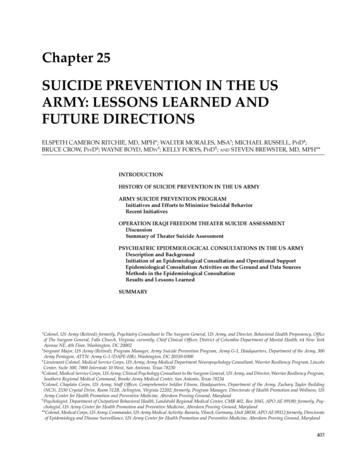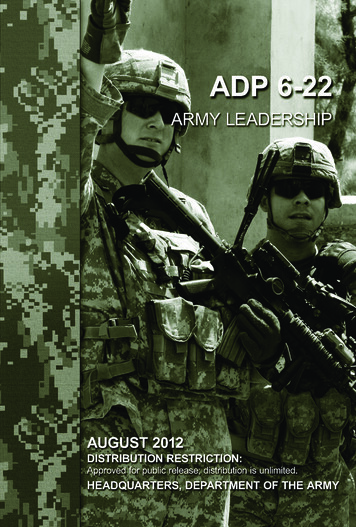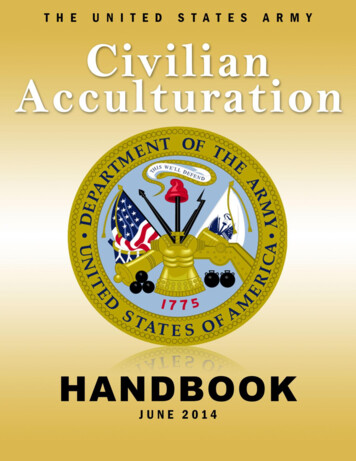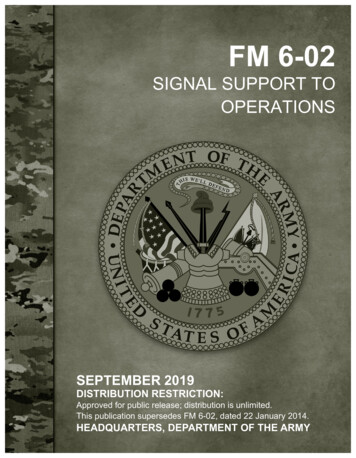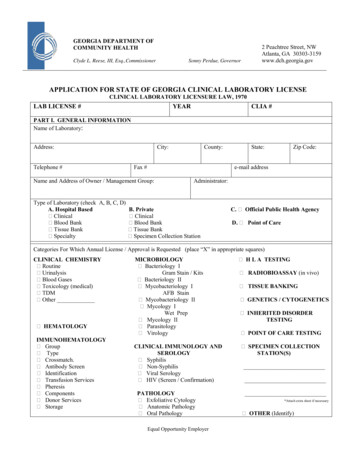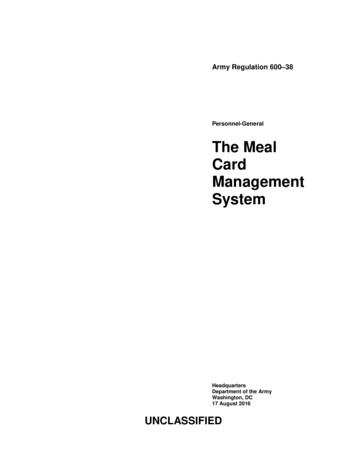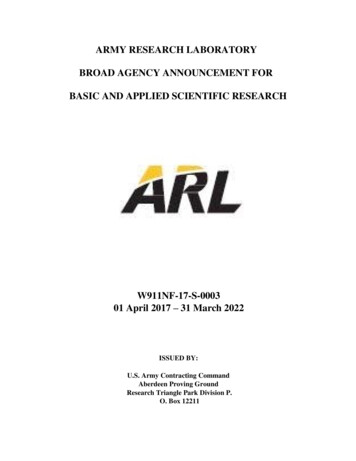
Transcription
ARMY RESEARCH LABORATORYBROAD AGENCY ANNOUNCEMENT FORBASIC AND APPLIED SCIENTIFIC RESEARCHW911NF-17-S-000301 April 2017 – 31 March 2022ISSUED BY:U.S. Army Contracting CommandAberdeen Proving GroundResearch Triangle Park Division P.O. Box 12211
Research Triangle Park, NC 27709-2211Special Notes1. Formatting of the AnnouncementThe following table provides an overview of the outline structure of this announcement:I.A.1.a.i.(1)(a)(i)2. See Appendix 1 for a Table of Acronyms used in this announcement.
TABLE OF CONTENTSI. OVERVIEW OF THE FUNDING OPPORTUNITYA. Required Overview Content1. Agency Name2. Research Opportunity Title3. Announcement Type4. Research Opportunity Number5. Catalog of Federal Domestic Assistance (CFDA) Number and Title6. Response DatesB. Additional Overview Information133333333II. DETAILED INFORMATION ABOUT THE FUNDING OPPORTUNITYA. Program Description1. COMPUTATIONAL SCIENCES (CS) CAMPAIGNa. KCI-CS-1: Tactical High Performance Computing (HPC)b. Real-time, Scalable Data Analytics for the Armyc. Computational Modeling of Complex Systemsd. Computing Sciences for Advanced and Unconventional ComputingArchitecturese. Supercomputing Technologiesf. Distributed Simulation, Integration, and Interoperability2. MATERIALS RESEARCH (MR) CAMPAIGNa. KCI-MR-1: Materials for Soldier and Platform Power Systemsb. KCI-MR-2: Energy Efficient Electronics and Photonicsc. KCI-MR-3: Agile Expedient Manufacturingd. KCI-MR-4: Quantum Sciencese. KCI-MR-5: Energy Coupled to Matter (ECM) for Responsive Materialsf. KCI-MR-6: Lightweight Materialsg. CCE-MR-1: Designing Materialsh. CCE-MR-2: Materials Synthesis and Processingi. CCE-MR-3: Materials Characterization and Discoveryj. Photonicsk. Position, Navigation, and Timing (PNT)l. Energy and Powerm. Biologically Derived Sensor, Power, Device and Materials Research (MR)n. RF to THz Devices and Integrated Circuit Technology3. SCIENCES FOR MANEUVER (ScMVR) 28
a. KCI-ScMVR-1: Force Protection and Augmentation through IntelligentVehiclesb. KCI-ScMVR-2: Advanced, Electrical Power Technologies and Componentsc. KCI-ScMVR-3: Discover and Advance Vertical Takeoff and Landing(VTOL) Innovations, Novel Concepts, and Ideasd. CCE-ScMVR-1: Advanced Switching and Control for Power Electronicse. CCE-ScMVR-2: High-Power Density and Energy-Efficient Engine andDrivetrain Technologiesf. CCE-ScMVR-3: Virtual Risk-Informed Agile Maneuver Sustainment(VRAMS)g. CCE-ScMVR-4: Mechanics and Dynamics of Complex Systemsh. Maneuver System Trade Space Methodology and Tools4. INFORMATION SCIENCES (IS) CAMPAIGNa. KCI-IS-1: Cyber Fire and Maneuver in Tactical Battleb. KCI-IS-2: Taming the Flash-Floods of Networked Battlefield Informationc. KCI-IS-3: Acting Intelligently in a Dynamic Battlefield of Information,Agents, and Humansd. KCI-IS-4: Sensing and Information Fusion for Advanced Indications andWarningse. CCE-IS-1: Networking and Communications in Contested and AustereEnvironmentsf. CCE-IS-2: Natural Language Processing (NLP) and Multi-Lingual Computingg. CCE-IS-3: Text and Video Analyticsh. CCE-IS-4: Atmospheric Boundary Layer Exploitationi. CCE-IS-5: Sensors, Sensor Phenomenology, and Algorithmsj. Electric and Magnetic-Field Sensor Technologyk. Artificial Intelligence and Machine Learningl. Technologies for Spectrum Analysis and Control5. SCIENCES FOR LETHALITY AND PROTECTION (ScL/P) CAMPAIGNa. KCI-ScL/P-1: Scalable Lethal Adaptable Weapons Conceptsb. KCI-ScL/P-2: Desired Lethal Effects at Standoff Ranges in ConstrainedEnvironmentsc. KCI-ScL/P-3: Soldier Lethality and Protectiond. KCI-ScL/P-4: Adaptive and Cooperative Protectione. KCI-ScL/P-5: Disruptive Energetic Materialsf. CCE-ScL/P-1: Vehicle Protection from Kinetic Threatsg. CCE-ScL/P-2: Terminal Ballistics and Blast Effects6. HUMAN SCIENCES (HS) CAMPAIGNa. KCI-HS-1: Robust Human and Machine Hybridizationb. KCI-HS-2: Multi-Faceted Assessment of Soldier 7484849495050515152525353
B.C.D.E.F.c. KCI-HS-3: Training Effectiveness Researchd. CCE-HS-1: Real World Behaviore. CCE-HS-2: Augmentationf. CCE-HS-3: Trainingg. CCE-HS-4: Humans in Multi-Agent Systems7. ANALYSIS AND ASSESSMENT (AA) CAMPAIGNa. KCI-AA-1: Methodology for A&A of Complex Systems and TechnologiesAcross Multiple Domainsb. KCI-AA-2: Visual, Interactive, Situational Analysis and Assessmentc. KCI-AA-3: Analysis and Assessment Methodology for Congested andContested Operational Environmentsd. CCE-AA-1: Ballistics Survivability, Lethality, and Vulnerability (SLV)e. CCE-AA-2: Cyber Survivability, Lethality, and Vulnerability (SLV)f. CCE-AA-3: Electromagnetic Environment (EME) and Warfareg. CCE-AA-4: Personnel Survivabilityh. CCE-AA-5: Human Systems Integration (HSI) Modeling and Analysisi. CCE-AA-6: Complex Adaptive Systems Analysis8. OTHER PROGRAMS: Visiting Scientist Program (VSP)9. Translational Research Innovative Application Discovery (TRIAD)Federal Award InformationEligibility Information1. Eligible Applicants2. Cost Sharing or Matching3. OtherApplication and Submission Information1. Address to View Broad Agency Announcement2. Content and Form of Application Submission3. Unique Entity Identifier and System for Award Management (SAM)4. Submission Dates and Times5. Intergovernmental Review6. Funding Restrictions7. Other Submission RequirementsApplication Review Information1. Criteria2. Review and Selection Process3. Recipient QualificationAward Administration Information1. Award Notices2. Administrative and National Policy Requirementsa. Required Representations and Certificationsb. Policy 79798080808093949494949595959697979898102
3. ReportingG. Agency ContactsH. Other Information1. Contract Proposals2. Grant and Cooperative Agreement ProposalsAPPENDIX 1: TABLE OF ACRONYMS107108109109117121
I. OVERVIEW OF THE FUNDING OPPORTUNITYThe U.S. Army Research Laboratory (ARL) is the Department of the Army’s corporate laboratoryand sole fundamental research laboratory. It is dedicated to scientific discovery, technologicalinnovation, and the transition of knowledge products. ARL is situated within the U.S. ArmyResearch, Development, and Engineering Command (RDECOM) – a U.S. Army MaterielCommand (AMC) Major Subordinate Command (MSC). The ARL mission is to “Discover,innovate, and transition Science and Technology (S&T) to ensure dominant strategic land power”.To accomplish its mission, ARL executes fundamental research to address enduring S&Tchallenges identified by the Assistant Secretary of the Army for Acquisition, Logistics, andTechnology [ASA(ALT)] and by priorities articulated by the Chief of Staff of the Army (CSA).In addition, the laboratory conducts research and analysis in emerging fields that may realizenovel or vastly improved Army capabilities into the deep future (2030 and beyond).For ease of reference and clarity, the ARL research funding opportunities are organized into twoseparate funding opportunity announcements: the ARL Broad Agency Announcement (BAA) andthe Army Research Office (ARO) BAA.The ARL BAA identifies topics of interest to the ARL Directorates (Computational andInformation Sciences Directorate, Human Research and Engineering Directorate, Sensors andElectron Devices Directorate, Survivability/Lethality Analysis Directorate, Vehicle andTechnology Directorate, and Weapons and Materials Research Directorate). The Directoratesfocus on executing in-house research programs, with a significant emphasis on collaborativeresearch with other organizations in an Open Campus setting (Open Campus opportunities aredescribed in detail at http://www.arl.army.mil/www/default.cfm?page 2357). The Directoratesfund a modest amount of extramural research in certain specific areas, and those areas aredescribed in this BAA.The ARL BAA seeks proposals from institutions of higher education, nonprofit organizations,state and local governments, foreign organizations, foreign public entities, and for-profitorganizations (i.e. large and small businesses) for research based on the following S&Tcampaigns: Computational Sciences, Materials Research, Sciences for Maneuver, InformationSciences, Sciences for Lethality and Protection, Human Sciences, and Assessment and Analysis.Further details are described in the ARL Technical Strategy and in the ARL S&T Campaignslocated at www.arl.army.mil. These documents are subject to periodic refinements which mayresult in taxonomy inconsistencies. These inconsistencies should not affect the efficacy of theBAA to present a complete portfolio of essential ARL research.The ARL BAA generally conforms to the portfolio structured around mission, enemy, KeyCampaign Initiatives (KCIs) and Core Campaign Enablers (CCEs). KCIs are substantive, longlived, primarily in-house technical programs focused on pursuing scientific discoveries,innovations, and knowledge product transitions that are expected to lead to greatly enhancedcapabilities for the operational Army of 2030 and beyond. KCIs reflect a robust yet aggressiveapproach, and are delineated by near-term, mid-term, and long-term trajectories. CCEs areenduring technical thrusts dedicated to a fundamental understanding of new concepts and the1
maturation of foundational technologies and methodologies. The essence of the ARL technicalportfolio is captured in the ARL Technical Strategy and by the ARL S&T Campaign Plans.Proposals are sought for cutting-edge innovative research that could produce discoveries with asignificant impact to enable new and improved Army technologies and related operationalcapabilities and related technologies. The specific research areas and topics of interest describedin this document should be viewed as suggestive, rather than limiting.Prospective applicants contemplating submission of a whitepaper or proposal are stronglyencouraged to contact the appropriate Technical Point of Contact (TPOC). The TPOCs’ names,telephone numbers, and email addresses are listed immediately after each research area of interest.If requested by the TPOC, a whitepaper should be prepared in accordance with the instructionscontained in this BAA. Upon receipt, a whitepaper will be evaluated and the applicant will beadvised of the results. Applicants whose whitepapers receive a favorable evaluation may beencouraged to prepare a proposal in accordance with instructions contained in this BAA. Thecosts of whitepapers and/or proposals in response to this BAA are not considered an allowabledirect charge to any award resulting from this BAA or any other award. It may be an allowableexpense to the normal bid and proposal indirect costs specified in FAR 31.205-18. Proposals maybe submitted at any time during the announcement period.The Army has a long history of advocating and supporting research at Historically Black Collegesand Universities and Minority-Serving Institutions (HBCU/MI). ARL welcomes proposals fromHBCUs and MIs in full competition with all applicants who may submit proposals under thisBAA. ARL also encourages the inclusion of HBCUs and/or MIs as part of a consortium proposalor as sub-recipients to prime recipients.In accordance with federal statutes, regulations, and Department of Defense (DoD) and Armypolicies, no person on grounds of race, color, age, sex, national origin, or disability shall beexcluded from participation in, be denied the benefits of, or be subjected to discrimination underany program or activity receiving financial assistance from the Army.Applicants submitting proposals are cautioned that only a Contracting or Grants Officer canobligate the Government to any legal instrument involving expenditure of Government funds.This BAA is also used to solicit research proposals for submission to the RDECOM InternationalTechnology Centers.All administrative inquiries regarding this BAA shall be submitted via email to:usarmy.rtp.aro.mbx.baa@mail.mil. Scientific and technical questions should be referred to theTPOCs shown following each research area of interest. Interested parties are encouraged toperiodically check any of the following websites for updates and amendments to this BAA:www.grants.gov, www.fbo.gov, and the ARL website, www.arl.army.mil/.PHILIP PERCONTIDirector,U.S. Army Research Laboratory2
(End of Section)A.Required Overview Content1. Agency Name:U.S. Army Research LaboratoryIssuing Acquisition Office:U.S. Army Contracting Command-Aberdeen Proving Ground, Research Triangle Park(ACCAPG-RTP) Division2. Research Opportunity Title:ARL Broad Agency Announcement (BAA) for Basic and Applied Scientific Research for 01April 2017 – 31 March 20223. Announcement Type: Amended Announcement4. Research Opportunity Number: W911NF-17-S-00035. Catalog of Federal Domestic Assistance (CFDA)Number and Title:12.431 – Basic Scientific Research6. Response Dates:This BAA is a continuously open announcement valid throughout the period from the date ofissuance through 31 March 2022, unless announced otherwise. This announcement succeedsARL BAA W911NF-12-R-0011 (including all amendments) dated 15 May 2012.(End of Section)B.Additional Overview InformationThis BAA sets forth research areas of interest to the ARL. This BAA is issued under paragraph6.102(d)(2) of the Federal Acquisition Regulation (FAR), which provides for the competitiveselection of basic and applied research proposals, and 10 U.S.C. 2358, 10 U.S.C. 2371, and 10U.S.C. 2371b, which provide the authorities for issuing awards under this announcement forbasic and applied research. The definitions of basic and applied research may be found at 32Code of Federal Regulations (CFR) 22.105.3
Proposals submitted in response to this BAA and selected for award are considered to be theresult of full and open competition and in full compliance with the provision of Public Law98369, "The Competition in Contracting Act of 1984" and subsequent amendments.The DoD agencies involved in this program reserve the right to select for award all, some, ornone of the proposals submitted in response to this announcement. Due to Government budgetuncertainties, no specific dollars have been reserved for awards under this BAA. Theparticipating DoD agencies will provide no funding for direct reimbursement of whitepaper orproposal development costs.Whitepapers and technical and cost proposals (or any other material) submitted in response tothis BAA will not be returned to the applicant. Unless noted in an applicant's proposal to thecontrary, unsuccessful proposals will be retained for six (6) months from declination and thenproperly destroyed. It is the policy of participating DoD agencies to treat all proposals assensitive, competitive information and to disclose their contents only for the purposes ofevaluation.An applicant may withdraw a proposal at any time before award by written notice or by emailsent to the government point of contact identified in Section G of this BAA.(End of Section)4
II. DETAILED INFORMATION ABOUT THE FUNDING OPPORTUNITYA.Program Description1.COMPUTATIONAL SCIENCES (CS) CAMPAIGNThe CS Campaign focuses on advancing the fundamentals of predictive simulation sciences,data intensive sciences, computing sciences, and emerging computing architectures totransform the future of complex Army applications. Gains made through these underpinningmultidisciplinary research efforts and exploiting emerging advanced computing systems willlead to scientific breakthroughs that are expected to have significant impact on Army materielsystems. Technologies resulting from this multidisciplinary research collaboratively with otherARL S&T campaign innovations will have a significant impact on Power ProjectionSuperiority, Information Supremacy, Lethality and Protection Superiority, and SoldierPerformance Augmentation for the Army of 2030.Represented in this BAA for the CS Campaign are one KCI and five CS-related topics that areintegrated to form a robust advanced computing foundation to understand and overcomecomplex fundamental challenges simultaneous to improving approaches of importance to theArmy, including weapon systems design; materials-by-design; information dominated andnetworked battle command applications; system-of-systems analyses; human performancemodeling; platform maneuverability; and tactical supercomputers. The campaign heavily relieson ARL’s research expertise and facilities devoted to emerging advanced computingarchitectures, mobile High Performance Computing (HPC), multi-scale and interdisciplinarypredictive simulation sciences, multi-dimensional distributed data analytics, and computingsciences. Discoveries and innovations made in this area will exert a significant impact on theArmy of the future. There are natural synergies among the challenges facing ARL’s CSCampaign and ARL’s other S&T campaigns. Synergistic advances across all campaigns areexpected to enable next generation scientific breakthroughs.a. KCI-CS-1: Tactical High Performance Computing (HPC)This KCI concentrates on understanding and exploiting the fundamental aspects of hardwareand associated system software for emergent and future computing architectures for mobile,scientific, and data intensive applications. Computing systems include both mobile andfixed/virtual architectures optimized for fast communications, low power consumption, largehierarchical memory, novel and robust algorithms, high resiliency, and HPC networking.i.Tactical HPC integrates four primary research areas, including 1) advanced computingresearch to facilitate the efficient use of emerging architectures; new algorithm design andanalysis approaches must be developed to boost the computing capacity of fixed and deployeddevices; 2) research in provisioning these systems within a distributed computing architecture;this work includes novel concepts to schedule computing tasks over friendly networked5
processors to limit network hop to appropriate resources; 3) dynamic binary translation to limitsoftware re-writes and facilitate optimization in a runtime environment to achieve maximumperformance; and 4) power- and architecture-aware computing for enhanced intelligence ofprovisioning systems to design systems that have greater awareness of their computingcapacity and mission appropriateness. The critical, mobile ad hoc networks that will form theconnections in tactical cloudlets to the large-scale databases and complex applications that willbe performed by these resources make this research uniquely military and Army in nature.Numerous applications are envisioned for this system in the future and include artificialintelligence aids for decision making, processing large-scale datasets (text, video), andnavigation systems for autonomous vehicles (HPC-enabled autonomous vehicles providing ondemand processing).ii.Emergent Computing Architectures research focuses on light weight architectures, largescale on-chip parallelism, and exascale performance to support petascale computing withmulticore processors. These research efforts are also dedicated to developing novel algorithmsand application formulations that facilitate the input and output rates required for petascalecomputing; and application development and performance optimization for next generationcomputing architectures.iii.Tactical Computing research is focused on better understanding algorithms andapplications which facilitate seamless reach back to large-scale HPC systems and help tosupply information to the Soldier at the tactical edge. Research in this area is dedicated tomoving beyond optimizing devices in isolation, and embraces the challenges of crossenvironment co-design to address the needs of emerging tactical applications.iv.Next Generation Computing Architectures research is focused on non-traditionalcomputing systems and envisioned to provide disruptive technologies for the Army. Cognitivecomputing, neuro-synaptic computing, and DNA computing are some emerging concepts.TPOC: Song Park, (410) 278-5444, song.j.park.civ@mail.milComputational Sciences (CS) Related Topics:b. Real-Time, Scalable Data Analytics for the ArmyThis topic focuses on understanding and exploiting the fundamental aspects of large-scale, realtime, multi-variate data analytics. Experiments, observations, and numerical simulations are onthe verge of generating extreme quantities of data at ever increasing rates that must beprocessed for understanding and consumption. These massive amounts of data are distributedacross disparate locations and pose a challenge in providing real-time analytics that supportU.S. military operations.6
i.Brain-inspired computing research addresses the fundamental question of how ourunderstanding of neuroscience, brain structure, and function inform the development ofcomputing architectures to address Army research challenges. For instance, current modelsunderlying existing machine learning are based on a 40 year old understanding of the structureand organization of animal brains. This research focuses on the design of neural networkstructures informed by our current understanding of the repeating micro-structure circuitsneuroscience has discovered in brains. The benefits of this research may be the discovery ofcomputing structures that are more powerful and learn more generally than the structurescurrently used.ii.Science of Large Data research is focused on pursuing theoretical developments andinnovations to provide immersion in high dimensional data and very large-scale sets. Theseefforts are dedicated to discovering, evolving, and maturing analytic algorithms that efficientlyscale to facilitate rapid analyses of massive data sets. The primary goal of this research area isto realize Army-relevant, high accuracy, predictive models based on massive data sets, whichtake advantage of emerging computing architectures. Additional areas of relevant researchinterest is maturation of methodologies to reduce data set dimensionality prior to modeling,thereby greatly shortening computational time.iii.Computational Methods for Large-scale data analytics research is focused onidentifying, evolving, and maturing innovative computational algorithms and methodologies todescribe, model, simulate, solve, explore, and optimize control and coordination ofcomputational systems impacted through physical events. Dynamic discrete event systems aredata intensive and exist in many technological applications relevant to the Army, fromcommunications to system-of-systems, to quantum sciences.iv.Data Intensive Computing Methods include the creation of scalable mathematicalalgorithms, predictive computational methods, real-time data analytics, model order reduction,human cognition based mathematical approaches, neuro- and biologically-inspired methods,science analyzing large-scale data from wearable electronics/technologies, large-scale datasensing/compression methodologies, large-scale visual analytics, live-virtual methods fortraining, data mining/learning mathematical algorithms for distributed heterogeneouscomputing systems. Computational scalable algorithmic research in cognitive behavior,artificial intelligence, human-machine interactions, and autonomous networks is also integral tothis work. Novel methods to create systems capable of computing in memory andaccommodating large amounts of unstructured data storage are critical to far-term success.v.Machine Learning and Artificial Intelligence research focuses on the development ofnew methods and algorithms, and how to optimally implement these approaches on emergingand specialized processors. The focus is to allow for novel discovery methods using machinelearning and artificial intelligence approaches, and also optimized processing speeds to allowfor satisfaction of fixed-time response requirements found in applications such as autonomousmaneuver.7
TPOC: Manuel Vindiola, (410) 278-9151, manuel.m.vindiola.civ@mail.mil.c. Computational Modeling of Complex SystemsThe subject topic concentrates on the fundamental aspects of CS to enable multi-disciplinaryand multi-scale modeling and simulation (M&S) to predict, quantify, assess, and optimize theperformance and response of complex systems, and system of systems, enabling rapid design,development, and transition particularly in cases where laboratory experimental approaches arecostly and difficult to conduct, and/or are not feasible. Proposals are requested for thefollowing areas:i.Computational Mathematics and Algorithms research encompasses a range ofdisciplines seeking computational methods to solve fundamental equations. Solutions may besought for existing equations, or new equations may be developed expressly for the purpose oftreating problems of interest to the Army. Problems in which the equations can be expressed inthe form of partial differential equations stem from the basic science and engineeringdisciplines spanning characteristic length scales from sub-atomic to continuum, neural signals,stochastic variables, and design theory. Broad classes of problems may also requireconsiderable specialization of solutions based on the platform used to obtain them.ii.Scientific Computing Research seeks understanding of phenomena that pertain to thescientific pursuits in and across traditional scientific disciplines that lack relevantcomputational capabilities. The problems are interdisciplinary, multi-physics with disparateintrinsic length and time scales. The equations, algorithms, and conceptual representation canchange with respect to multi-dimensions (including space and time traversing scales orcrossing the boundaries between scientific disciplines). Simulations bridging multi-scaledomains are instrumental in discovering and revealing mechanisms and physics-basedpredictions (e.g., in materials, chemical and biological dispersion; micro-systems; biologicalecosystems; and computer and human networks). High fidelity computations at the individualrelevant scales, as well as research into mathematics and computational algorithms bridgingthese scales through innovative and scalable methodologies, including finite element methods,particle methods, and meshless methods applied to Computational Mechanics, ComputationalFluid Dynamics (CFD), Computational Structural Mechanics (CSM), ComputationalElectromagnetics and Acoustics (CEA), and Computational Chemistry and Materials (CCM),are required.iii.Applied Computer Modeling and Analysis is focused on using predictive and reliablecomputational capabilities and tools to impact the design and deployment of critical Armysystems and devices. CS-based enabling tools are required to perform large-scale systemanalysis from complex model development to detailed analytics. This includes innovative andscalable methods for Discrete Event Simulation (DES) that can be useful to a wide variety ofperformance and optimization problems in complex Army systems.8
iv.Uncertainty Quantification (UQ) research is focused on determining and quantifyingsimulations performance as intended, considering the range of conditions where models andsimulations reproduce observed behavior within acceptable tolerances and establishedconfidence levels. UQ research is concerned with novel and efficient concepts andmethodologies for high-fidelity assessment on the level of agreement in sets of models relativeto input and output data, as well as the variations in interdependent models due to variousphysics, mathematical, and numerical assumptions. UQ methodologies, integrated with datasciences and machine learning will enable tools for: (1) identifying deficiencies in simulations;(2) setting guidelines for adequacy of computational results; (3) exploring the impact of knownvariability and uncertainty of input; and (4) control of adaptive algorithms to achieve specifiedlevels of accuracy to aid decisions from design to operational planning.v.Multi-scale Modeling focuses on the development of new systems and models ofcomplex phenomena by significantly reducing development time and evaluation costs. Thisgoal can be achieved with: 1) high-fidelity physical models at multiple scales; and 2)computational methodologies (numerical methods and associated algorithms) to enable rapidcreation of new high-fidelity multi-scale computer models of complex systems capable ofutilizing modern extreme-scale computing.The success of multi-scale modeling hinges on the ability to combine at-scale models into amulti-scale model. However, few numerical methodologies and associated algorithms havebeen developed so far to enable such scale-bridging. Moreover, many at-scale models areextremely demanding computationally and render any multi-scale model utilizing themunsuitable for practical applications. While surrogate modeling allows reduction of thiscomputational cost, most methodologies for surrogate modeling are global, and thus arecharacterized by a relatively high cost. New adaptive, non-local surrogate modelingmethodologies are needed, which can bring the computational cost to tractable levels. Finally,at-scale models are frequently endowed with uncertainty due to various sources, such as naturalfluctuations, model parameters, or model form. This uncertainty and natural variability mustbe consistently incorporated into multi-scale computer models in order to enable computationaldesign.(1) Four main areas will be the focus of the effort in multi-scale CS:(a) Hierarchical Multi-scale Framework(b) Discrete Dislocation Dynamics(c) Phonon and Electron Transport(d) Density Functional Theory(2) The strategic approach to these focus areas include:(a) Shortened development time and evaluation costs of novel energetic materials byallowing macro-scale response to be accurately predicted directly from composition andchemical reactivity at the molecular level.9
(b) Development of novel materials for battery applications through expeditedcomputational evaluation of potential compositions.(c) Advanced Soldier protective equipment and vehicle occ
1. Address to View Broad Agency Announcement 80 2. Content and Form of Application Submission 80 3. Unique Entity Identifier and System for Award Management (SAM) 93 4. Submission Dates and Times 94 5. Intergovernmental Review 94 6. Funding Restrictions 94 7. Other Submission Requirements 94 E. Application Review Information 95 1.




